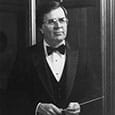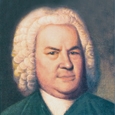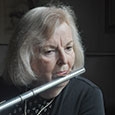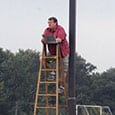The word Baroque is derived from the Portuguese word barroco meaning an irregularly or grotesquely shaped pearl. However, when applied to music, the word refers to a style of artistic expression used predominantly throughout Western Europe between 1600 and 1750. It was a style that was exaggerated, unconventional, and highly ornamented. The music was by no means grotesque, but simply different or irregular from the previous norm of the Renaissance (1450-1600).
For the first time in music history, composers of the Baroque period wrote music especially conceived for vocalists or for instrumentalists. While vocal and organ music was primarily written for use in church services, most instrumental music was written to be performed either in the church or in a secular venue. The favored instrumental forms were the sonata, concerto and suite.
In the early Baroque, the term sonata literally meant a sounded piece as opposed to a sung piece. It consisted of four movements which contrasted in tempo (slow, fast, slow, fast). Slow movements ending with light double bar lines were intended to segue into the following fast movement with very little pause between movements. The fast movements often had imitative textures.
The sonatas were composed for instruments such as violin and continuo, flute and continuo or trio sonatas for two solo instruments and continuo. The Baroque sonata was written with a homophonic texture (melody over a bass line).
Many of the solo sonatas were written on two staff lines. The top staff was used for the solo instrument (melody) and the bottom staff (accompaniment) for the bass line and figured bass. The figured bass indicated to the harpsichord player which chords to use to realize the basso continuo part. In performance, the basso continuo (harpsichord) was reinforced by a low-pitched instrument such as the bassoon or viol da gamba. Realized continuo parts are often available for purchase today since many keyboard players have limited experience with figured bass.
Sonatas were either of the sonata da chiesa (for the church) or sonata da camera (for the chamber) variety. By looking at the movement titles, you can tell which type of sonata you are playing. If any of the movements has a dance indication (sarabande, gigue, minuet), the sonata is a sonata da camera. If the sonata movement only has a tempo indication (largo, andante, allegro), it is a sonata da chiesa.
Dynamics were rarely written in the music. The player was expected to shape the phrase dynamically. Generally if the line ascended, the dynamic became louder and the reverse if it descended. Remember the dynamic range of most Baroque instruments was quite small. If dynamics were printed at all, strongly contrasted dynamics were favored (f to p). Terracing of dynamics was used in sequential passages.
Sometimes the composer wrote in all the slurs he wanted making it unnecessary to add additional ones, but more often composers wrote in few slurs leaving it to the performer to decide what to do. Since much of the music of the Baroque is based on the idea of dancing, it is good to remember Quantz’s dictum: “The notes must not appear to be glued together.” In other words, a small space or articulatory silence between notes brings out the dancing quality of the music.
Since Baroque music is based on the idea of dancing, the strength of the beat concept (as in 2/4 meter, the first beat is strong and the second beat is weak) is applied. Melodies were through-composed and were rarely in two-, three- or four-bar phrase lengths. The performer was expected to read figured bass and embellish the melodic line with grace notes and ornaments. Jean-Claude Veilhan’s The Rules of Musical Interpretation in the Baroque Era (Leduc, 1977) is a valuable resource to learn to apply the rules of embellishment.
In the Baroque, many believed the principal goal of music was to arouse the passions or affections (love, hate, fear, joy). The Doctrine of “Affections” stated that each movement should possess only one affection or mood. However, it was possible to contrast moods in different movements.
Sonatas were written in major and minor tonalities. With the advent of the equal temperament tuning system, many composers wrote sonatas in an ever widening array of keys. Many Baroque flute sonatas are in the keys of G and D.
The quality of instrumental musical performance during the Baroque was not impressive by today’s standards, as most instrumentalists held non-musical jobs and had little time to practice. The instruments of the day were not technically advanced either, so many passages, which are easily executed on a contemporary instrument offered a distinctive set of problems.






